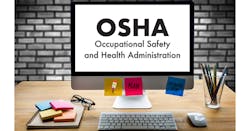The deadlines are fast approaching for employers to file their mandatory illness and injury reports with the Occupational Safety and Health Administration (OSHA), and you need to know about some of the changes that have taken place since you filled out last year’s reports.
Feb. 1 is the deadline for posting Form 300A in the workplace, which is the summary of serious workplace injuries and illnesses from the previous year. It must be posted in a location that is clearly visible to all employees and new applicants, and it must be kept posted until April 30. In addition, employees have the right to request a copy of the records at any time.
March 2 is the deadline for employers to file directly with OSHA their 300A and two other reports—Forms 300 and 301. In regard to Form 300, employers with 10 or more employees are required by law to record work-related deaths and injuries or illnesses that involve loss of consciousness, restricted work activity or job transfer, days away from work or medical treatment by healthcare professionals beyond first aid.
Keep in mind that Form 300A is the second page of the OSHA Form 300, and 301 serves as an addendum to 300. The Form 300A report filed with OSHA serves as a summary of all work-related injuries and illnesses. Employers are expected to include the number of cases, days away from work, and injury or illness, which are then added up for a total figure.
The last page of the reporting document is OSHA’s Form 301, where employers can describe the workplace injury or illness in more detail. Each injury or illness that an employer records on OSHA Form 300 must also be recorded on a Form 301. Employees, former employees and employee representatives (usually labor unions) are authorized to review OSHA 300 logs, except when it comes to information that raises privacy concerns.
The changes for this year were made by OSHA last year in order to reverse Obama-era agency requirements for electronic reporting of the three forms. Before the 2019 change, employers with 250 or more employees were required to electronically submit all three forms directly to OSHA.
Under the rules change, employers with 250 or more employees and with 20 to 249 employees in certain designated industries must continue to electronically submit Form 300A each year.
Remember that employers are required to report any worker fatality within eight hours of the incident and any amputation, loss of an eye or hospitalization of a worker within 24 hours. OSHA recently updated its National Emphasis Programs (NEP) for amputations in manufacturing industries by adding a targeting methodology for segments with high employer-reported amputation statistics.
Make no mistake, satisfying these reporting requirements is important for employers. In Fiscal Year 2019, OSHA conducted 33,401 inspections—more than in the previous three years—addressing violations related to trenching, falls, chemical exposure, silica and a long list of other hazards.
On the other hand, “over-reporting workplace accidents is a common mistake among employers and it can lead to unnecessary, costly and burdensome OSHA inspections,” according to attorney Othiamba Lovelace of the law firm of Chiesa Shahinian & Giantomasi.
“Properly identifying your OSHA reporting requirements can be difficult, but it is worth your time to make sure that you are only reporting accidents that need to be reported,” Lovelace points out. “You certainly do not want OSHA knocking on your door in 2020 because you unnecessarily filed your OSHA forms electronically like you used to back in 2016. So, it is important to be aware of your reporting requirements in this ever-changing web of OSHA regulations.”
About the Author

David Sparkman
David Sparkman is founding editor of ACWI Advance, the newsletter of the American Chain of Warehouses Inc. He also heads David Sparkman Consulting, a Washington, D.C. area public relations and communications firm. Prior to these he was director of industry relations for the International Warehouse Logistics Association. Sparkman has also been a freelance writer, specializing in logistics and freight transportation. He has served as vice president of communications for the American Moving and Storage Association, director of communications for the National Private Truck Council, and for two decades with American Trucking Associations on its weekly newspaper, Transport Topics.
